Exploring the Potential of Green Hydrogen Production and Application in the Antofagasta Region of Chile
Abstract
1. Introduction
2. Antofagasta as a HUB of Green Hydrogen
Green Hydrogen Mobile Pilot Plant
- Distance between points: A maximum of 100 km between consecutive points has been set.
- Altitude variation: The campaign will prioritize validation at different altitudes up to those relevant to the mining industry (~4000 m above sea level) in order to obtain data of the sensitivity of the PEM Fuel Cell to altitude.
- Solar irradiation: The Antofagasta Region has favorable irradiation conditions, but local topography may affect the performance of photovoltaic panels. Thus, this factor has been considered as well.
- Logistics: Diverse factors, including proximity to roads, terrain inclination, topographical flatness of the terrain, availability of municipal permits, access for transport trucks, and the public or private nature of the domain.
3. Future and Perspectives
Supplementary Materials
Author Contributions
Funding
Data Availability Statement
Conflicts of Interest
References
- Bethoux, O. Hydrogen Fuel Cell Road Vehicles and Their Infrastructure: An Option towards an Environmentally Friendly Energy Transition. Energies 2020, 13, 6132. [Google Scholar] [CrossRef]
- Bhaskar, A.; Assadi, M.; Nikpey Somehsaraei, H. Decarbonization of the Iron and Steel Industry with Direct Reduction of Iron Ore with Green Hydrogen. Energies 2020, 13, 758. [Google Scholar] [CrossRef]
- Qazi, U.Y. Future of Hydrogen as an Alternative Fuel for Next-Generation Industrial Applications; Challenges and Expected Opportunities. Energies 2022, 15, 4741. [Google Scholar] [CrossRef]
- Agnolucci, P.; McDowall, W. Designing Future Hydrogen Infrastructure: Insights from Analysis at Different Spatial Scales. Int. J. Hydrog. Energy 2013, 38, 5181–5191. [Google Scholar] [CrossRef]
- Pawłowski, A.; Żelazna, A.; Żak, J. Is the Polish Solar-to-Hydrogen Pathway Green? A Carbon Footprint of AEM Electrolysis Hydrogen Based on an LCA. Energies 2023, 16, 3702. [Google Scholar] [CrossRef]
- Nazir, H.; Muthuswamy, N.; Louis, C.; Jose, S.; Prakash, J.; Buan, M.E.M.; Flox, C.; Chavan, S.; Shi, X.; Kauranen, P.; et al. Is the H2 Economy Realizable in the Foreseeable Future? Part III: H2 Usage Technologies, Applications, and Challenges and Opportunities. Int. J. Hydrog. Energy 2020, 45, 28217–28239. [Google Scholar] [CrossRef] [PubMed]
- Nemmour, A.; Inayat, A.; Janajreh, I.; Ghenai, C. Green Hydrogen-Based E-Fuels (E-Methane, E-Methanol, E-Ammonia) to Support Clean Energy Transition: A Literature Review. Int. J. Hydrog. Energy 2023, in press. [Google Scholar] [CrossRef]
- Yousefi Rizi, H.; Shin, D. Green Hydrogen Production Technologies from Ammonia Cracking. Energies 2022, 15, 8246. [Google Scholar] [CrossRef]
- Rozzi, E.; Minuto, F.D.; Lanzini, A.; Leone, P. Green Synthetic Fuels: Renewable Routes for the Conversion of Non-Fossil Feedstocks into Gaseous Fuels and Their End Uses. Energies 2020, 13, 420. [Google Scholar] [CrossRef]
- Gallardo, F.I.; Monforti Ferrario, A.; Lamagna, M.; Bocci, E.; Astiaso Garcia, D.; Baeza-Jeria, T.E. A Techno-Economic Analysis of Solar Hydrogen Production by Electrolysis in the North of Chile and the Case of Exportation from Atacama Desert to Japan. Int. J. Hydrog. Energy 2021, 46, 13709–13728. [Google Scholar] [CrossRef]
- Armijo, J.; Philibert, C. Flexible Production of Green Hydrogen and Ammonia from Variable Solar and Wind Energy: Case Study of Chile and Argentina. Int. J. Hydrog. Energy 2020, 45, 1541–1558. [Google Scholar] [CrossRef]
- Ferrada, F.; Babonneau, F.; Homem-de-Mello, T.; Jalil-Vega, F. The Role of Hydrogen for Deep Decarbonization of Energy Systems: A Chilean Case Study. Energy Policy 2023, 177, 113536. [Google Scholar] [CrossRef]
- Correa, A.M.; Barría, Q.C.; Maluenda, P.B. National Green Hydrogen Strategy. Available online: https://energia.gob.cl/sites/default/files/national_green_hydrogen_strategy_-_chile.pdf (accessed on 11 April 2023).
- Anuario Estadistico de Energía. 2021. Available online: https://www.cne.cl/wp-content/uploads/2022/07/AnuarioEstadisticoEnergia2021.pdf (accessed on 23 May 2023).
- Palma-Behnke, R.; Abarca del Rio, R.; Agostini, C.; Alvear, C.; Amaya, J.; Araya, P.; Arellano, N.; Arriagada, P.; Aviles, C.; Barria, C.; et al. The Chilean Potential for Exporting Renewable Energy. Available online: https://www.researchgate.net/publication/356411969_The_Chilean_Potential_for_Exporting_Renewable_Energy (accessed on 11 April 2023).
- Acosta, K.; Salazar, I.; Saldaña, M.; Ramos, J.; Navarra, A.; Toro, N. Chile and Its Potential Role Among the Most Affordable Green Hydrogen Producers in the World. Front. Environ. Sci. 2022, 10, 890104. [Google Scholar] [CrossRef]
- Masip Macía, Y.; Rodríguez Machuca, P.; Rodríguez Soto, A.A.; Carmona Campos, R. Green Hydrogen Value Chain in the Sustainability for Port Operations: Case Study in the Region of Valparaiso, Chile. Sustainability 2021, 13, 13681. [Google Scholar] [CrossRef]
- State Will Press Green Hydrogen Ambitions in Chile. 2022. Available online: https://www.emerald.com/insight/content/doi/10.1108/OXAN-DB267846/full/html (accessed on 23 May 2023).
- Bartlett, J. Chile’s Bet on Green Hydrogen. Available online: https://www.imf.org/en/Publications/fandd/issues/2022/12/country-case-chile-bet-on-green-hydrogen-Bartlett (accessed on 23 May 2023).
- Informe Preliminar Prevision de Demanda 2021–2041 Sistema Eléctrico Nacional y Sistemas Medianos. Available online: https://www.cne.cl/wp-content/uploads/2021/12/Informe-Preliminar-Prevision-de-Demanda-2021-2041.pdf (accessed on 11 April 2023).
- Solargis. Available online: https://solargis.com/es/maps-and-gis-data/download/chile (accessed on 11 April 2023).
- Marzo, A.; Ferrada, P.; Beiza, F.; Besson, P.; Alonso-Montesinos, J.; Ballestrín, J.; Román, R.; Portillo, C.; Escobar, R.; Fuentealba, E. Standard or Local Solar Spectrum? Implications for Solar Technologies Studies in the Atacama Desert. Renew. Energy 2018, 127, 871–882. [Google Scholar] [CrossRef]
- Minemoto, T.; Nagae, S.; Takakura, H. Impact of Spectral Irradiance Distribution and Temperature on the Outdoor Performance of Amorphous Si Photovoltaic Modules. Sol. Energy Mater. Sol. Cells 2007, 91, 919–923. [Google Scholar] [CrossRef]
- Nakayama, K.; Tsuji, M.; Chantana, J.; Kawano, Y.; Nishimura, T.; Hishikawa, Y.; Minemoto, T. Description of Short Circuit Current of Outdoor Photovoltaic Modules by Multiple Regression Analysis under Various Solar Irradiance Levels. Renew. Energy 2020, 147, 895–902. [Google Scholar] [CrossRef]
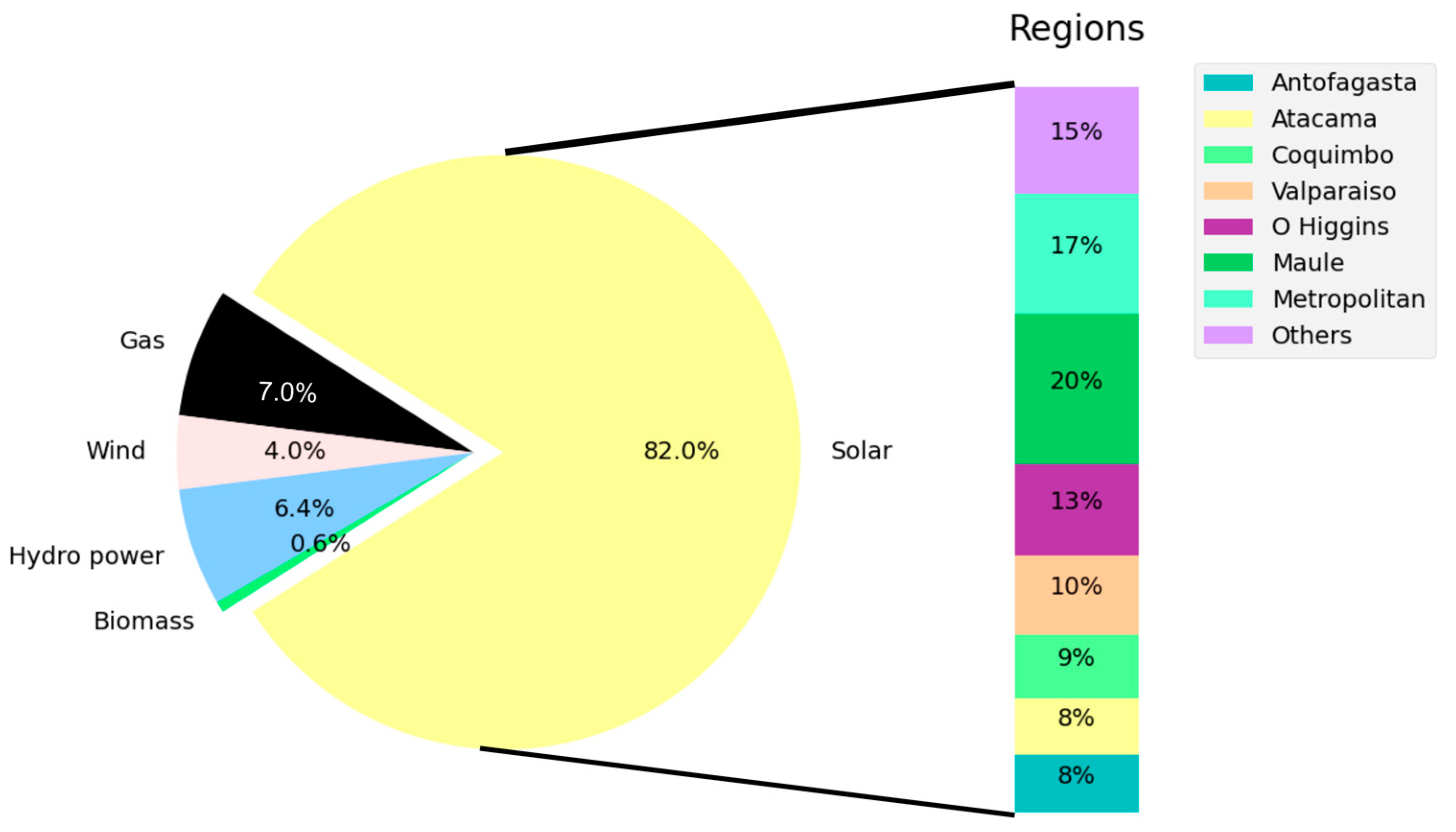
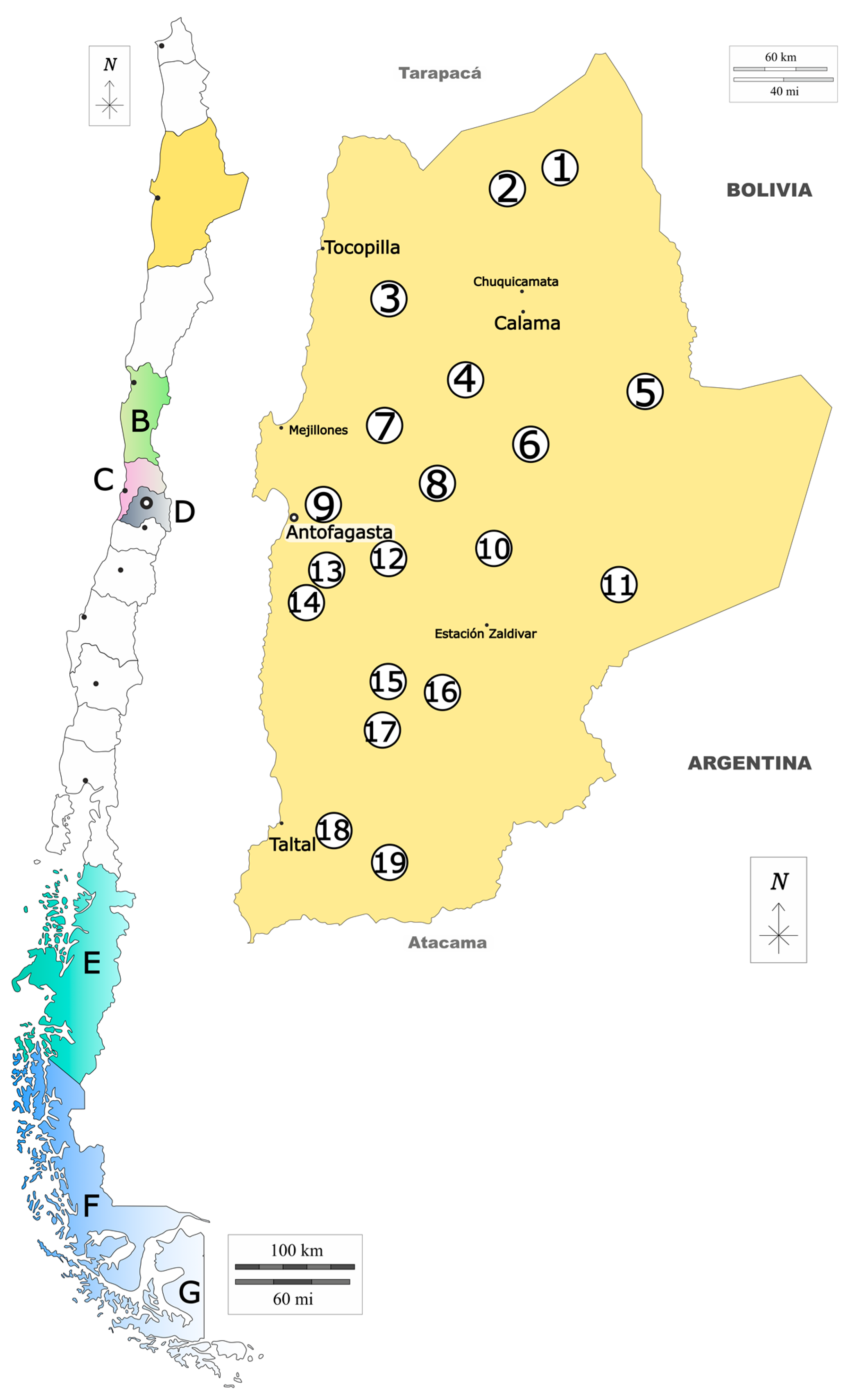


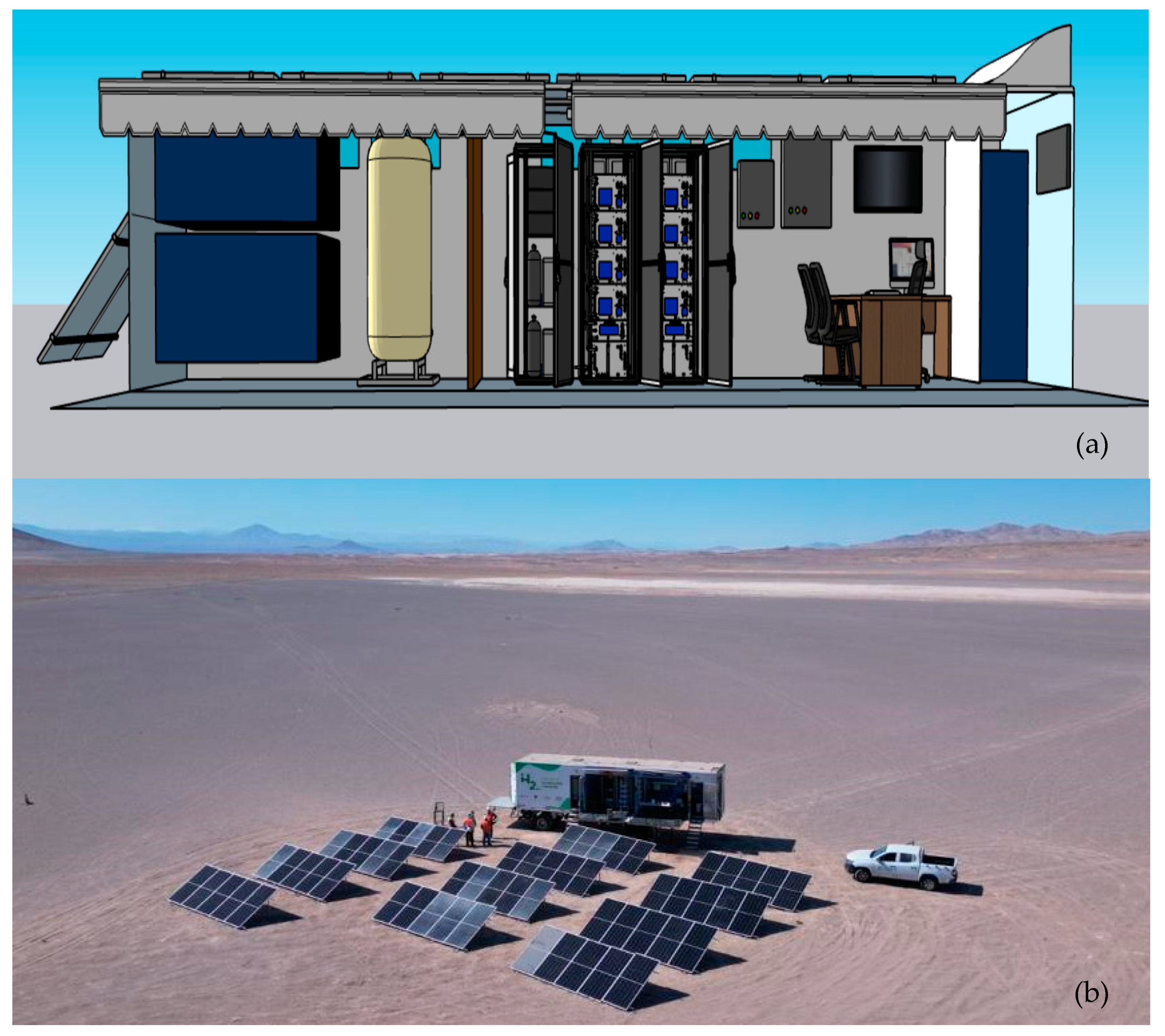
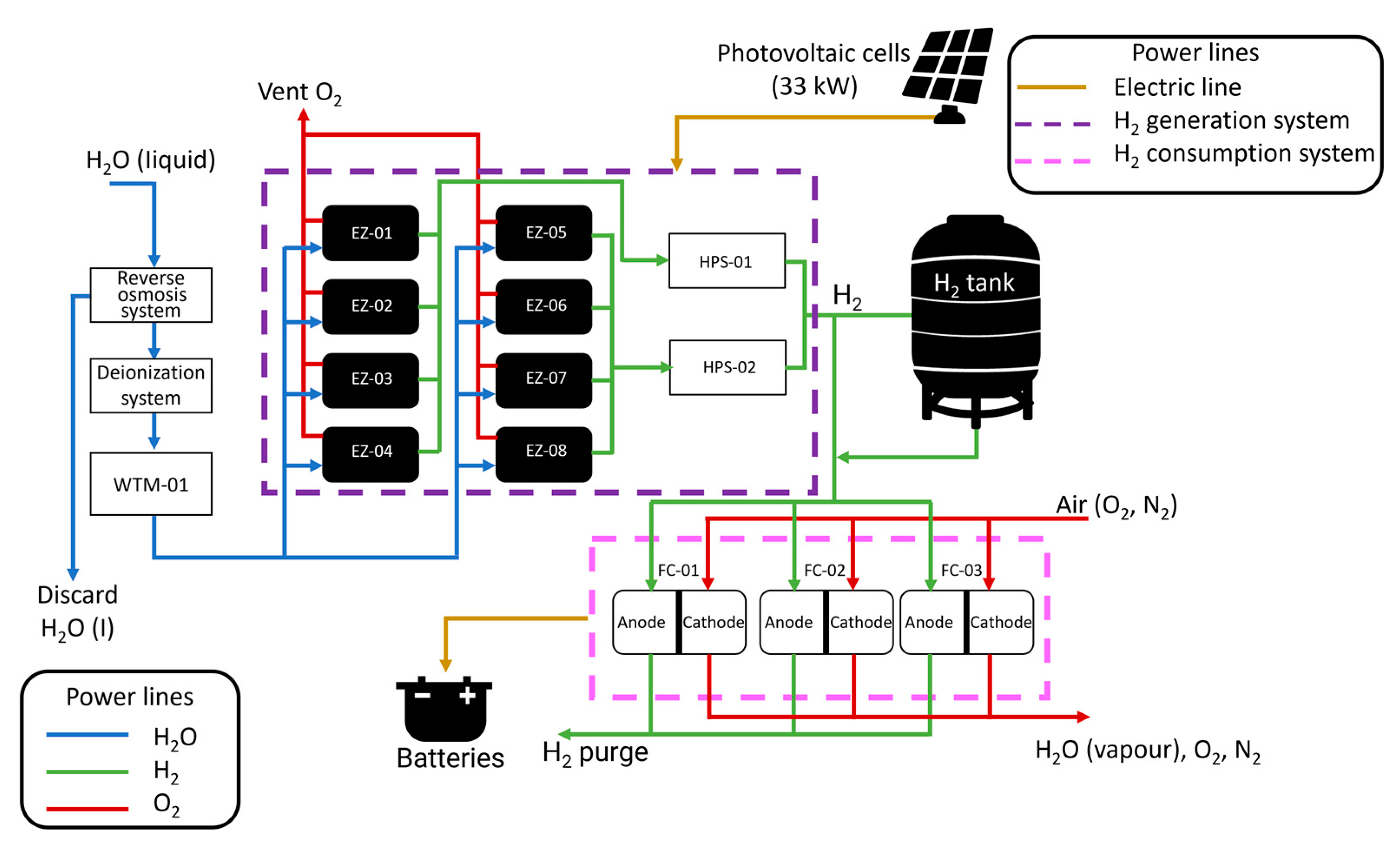
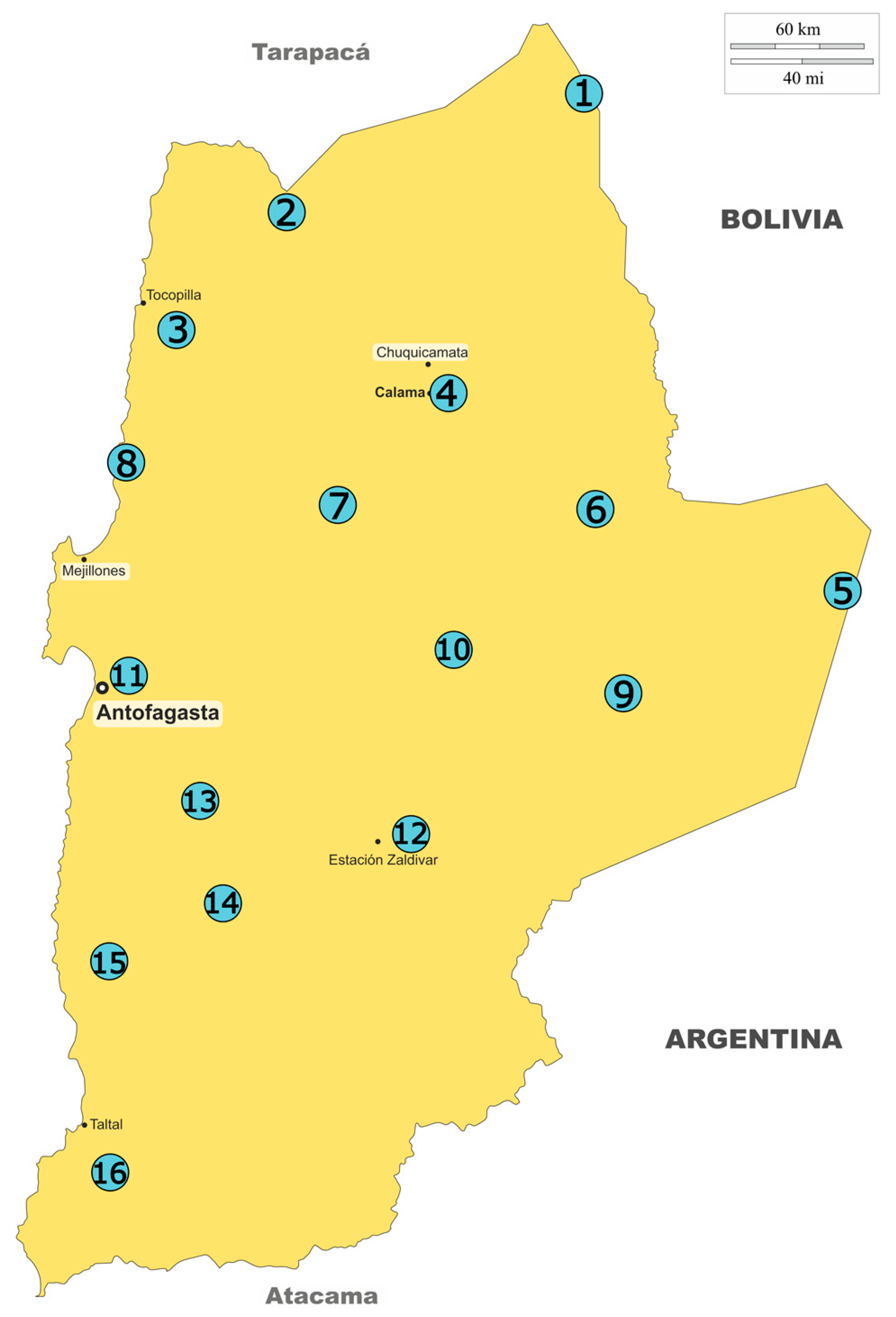
| Hydrogen Projects in Antofagasta Region | |
|---|---|
| 1 Amer H2 (Methanol) | 11 Hydra (H2: LD) |
| 2 Cerro Pabellón (H2: LD *) | 12 Tren a hidrogeno (H2: LD) |
| 3 Planta Movil H2V (H2: LD) | 13 HyEx (NH3: LD Ex) |
| 4 Pauna Greener Future (H2, HN3: LD, Ex †) | 14 Tango (NH3: Ex) |
| 5 San Pedro de Atacama (H2: LD) | 15 Proyecto H2V GNA (H2: LD) |
| 6 Power to ammonia AES Andes (NH3: Ex) | 16 Proyecto H2V Inversiones Farias (H2) |
| 7 HOASIS (NH3: LD, Ex) | 17 Genesis (H2: LD) |
| 8 Faraday (NH3: Ex) | 18 Paracelsus (H2: LD) |
| 9 H2 solar projects (H2: LD) | 19 METH2 Atacama (E-Methanol: LD, Ex) |
| 10 Cerro Dominador (H2: LD) | |
| Hydrogen projects in other Regions | |
(B) Coquimbo Region (LD):
| (F) Aysen Region (LD)
|
(C) Valparaiso Region (LD):
| (G) Magellan Region (Ex)
|
(D) Metropolitan Region (LD):
| |
(E) Biobio Region (LD)
| |
| Technology | Status of the Project | Total | ||||||||||
|---|---|---|---|---|---|---|---|---|---|---|---|---|
| Approved | Under Construction | Under Classification | Testing | Operational | ||||||||
| # † | MW | # | MW | # | MW | # | MW | # | MW | # | MW | |
| Solar photovoltaic | 56 | 8120 | 21 | 1366 | 7 | 2802 | 9 | 755 | 30 | 1669 | 123 | 15,012 |
| Solar photovoltaic + BESS * | 2 | 235 | 3 | 259 | 1 | 85 | 0 | 0 | 0 | 0 | 6 | 579 |
| Thermosolar | 7 | 1687 | 0 | 0 | 1 | 300 | 0 | 0 | 1 | 108 | 9 | 2045 |
| Geothermal | 0 | 0 | 0 | 0 | 0 | 0 | 1 | 33 | 1 | 39 | 2 | 72 |
| Eolic | 10 | 2645 | 3 | 280 | 4 | 2055 | 1 | 12 | 6 | 793 | 24 | 5785 |
| BESS | 2 | 168 | 1 | 2 | 1 | 57 | 0 | 0 | 3 | 52 | 7 | 279 |
| Carnot battery | 0 | 0 | 0 | 0 | 1 | 560 | 0 | 0 | 0 | 0 | 1 | 560 |
| Biomass | 1 | 322 | 0 | 0 | 0 | 0 | 0 | 0 | 0 | 0 | 1 | 322 |
| Location | Latitude | Longitude | |
|---|---|---|---|
| 1 | Ollagüe | 21°13′2.40″ S | 68°14′28.82″ W |
| 2 | Quillagua | 21°42′17.49″ S | 69°32′0.05″ W |
| 3 | Barriles | 22°9′58.77″ S | 70°1′7.65″ W |
| 4 | Calama | 22°26′3.76″ S | 68°51′31.52″ W |
| 5 | Pass Jama/ALMA Observatory | 23°13′38.25″ S | 67°5′50.34″ W |
| 6 | San Pedro de Atacama | 22°54′48.35″ S | 68°10′59.52″ W |
| 7 | Sierra Gorda | 22°53′3.16″ S | 69°18′44.53″ W |
| 8 | Michilla | 22°42′6.80″ S | 70°16′25.29″ W |
| 9 | Peine | 23°39′53.88″ S | 68°4′19.07″ W |
| 10 | Mine Gabriela Mistral | 23°29′24.76″ S | 68°48′55.43″ W |
| 11 | Baquedano | 23°33′53.08″ S | 70°14′34.97″ W |
| 12 | Mine Zaldívar/Escondida | 24°13′57.79″ S | 69°0′6.23″ W |
| 13 | PSDA Antofagasta | 24°5′24.14″ S | 69°55′44.29″ W |
| 14 | Pan American Highway North, Route 5 | 24°29′48.43″ S | 69°50′31.43″ W |
| 15 | Paranal Observatory | 24°43′46.03″ S | 70°21′49.35″ W |
| 16 | Taltal | 25°34′7.19″ S | 70°21′51.00″ W |
Disclaimer/Publisher’s Note: The statements, opinions and data contained in all publications are solely those of the individual author(s) and contributor(s) and not of MDPI and/or the editor(s). MDPI and/or the editor(s) disclaim responsibility for any injury to people or property resulting from any ideas, methods, instructions or products referred to in the content. |
© 2023 by the authors. Licensee MDPI, Basel, Switzerland. This article is an open access article distributed under the terms and conditions of the Creative Commons Attribution (CC BY) license (https://creativecommons.org/licenses/by/4.0/).
Share and Cite
Chavez-Angel, E.; Castro-Alvarez, A.; Sapunar, N.; Henríquez, F.; Saavedra, J.; Rodríguez, S.; Cornejo, I.; Maxwell, L. Exploring the Potential of Green Hydrogen Production and Application in the Antofagasta Region of Chile. Energies 2023, 16, 4509. https://doi.org/10.3390/en16114509
Chavez-Angel E, Castro-Alvarez A, Sapunar N, Henríquez F, Saavedra J, Rodríguez S, Cornejo I, Maxwell L. Exploring the Potential of Green Hydrogen Production and Application in the Antofagasta Region of Chile. Energies. 2023; 16(11):4509. https://doi.org/10.3390/en16114509
Chicago/Turabian StyleChavez-Angel, Emigdio, Alejandro Castro-Alvarez, Nicolas Sapunar, Francisco Henríquez, Javier Saavedra, Sebastián Rodríguez, Iván Cornejo, and Lindley Maxwell. 2023. "Exploring the Potential of Green Hydrogen Production and Application in the Antofagasta Region of Chile" Energies 16, no. 11: 4509. https://doi.org/10.3390/en16114509
APA StyleChavez-Angel, E., Castro-Alvarez, A., Sapunar, N., Henríquez, F., Saavedra, J., Rodríguez, S., Cornejo, I., & Maxwell, L. (2023). Exploring the Potential of Green Hydrogen Production and Application in the Antofagasta Region of Chile. Energies, 16(11), 4509. https://doi.org/10.3390/en16114509








